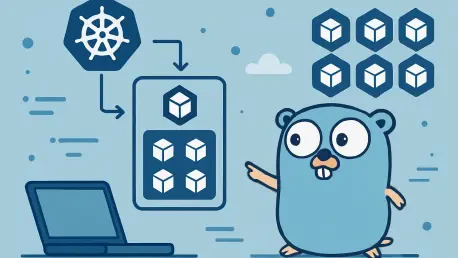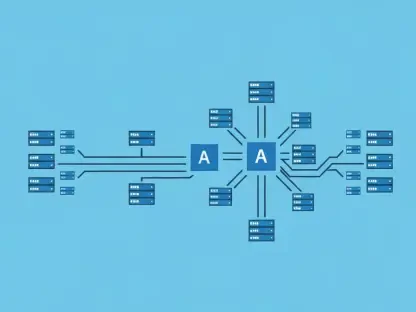In the rapidly evolving landscape of software development, building applications that can handle massive scale and maintain high performance is a critical challenge for developers and organizations alike. Golang, often referred to as Go, stands out as a programming language designed for efficiency and concurrency, making it an ideal choice for creating robust, scalable applications. When paired with Kubernetes, the leading platform for container orchestration, this combination offers a powerful solution for deploying and managing microservices that can adapt to fluctuating demands. Kubernetes provides the infrastructure to scale applications seamlessly while ensuring resilience through features like self-healing and load balancing. This guide aims to walk through the essential steps and considerations for deploying a Golang application on Kubernetes, offering practical insights into harnessing the strengths of both technologies. By following these strategies, developers can build systems that are not only efficient but also capable of meeting the needs of modern, dynamic workloads.
1. Understanding the Power of Golang and Kubernetes
Golang has gained prominence for its ability to deliver high-performance applications, thanks to its lightweight concurrency model using goroutines and channels. This design allows developers to handle thousands of simultaneous tasks efficiently, making it a go-to language for building scalable systems. Additionally, Go compiles quickly into statically linked binaries, simplifying the deployment process by eliminating runtime dependencies. This efficiency is crucial for environments where rapid iteration and deployment are necessary. When considering scalability, Golang’s minimal memory footprint and fast execution speed ensure that applications can handle increased loads without excessive resource consumption. These characteristics make it particularly well-suited for microservices architectures, where individual components must operate independently and scale on demand.
Kubernetes complements Golang’s strengths by providing a robust platform for container orchestration. It enables the deployment, scaling, and management of containerized applications with ease, ensuring that systems remain operational even under heavy traffic. Features like self-healing, where Kubernetes automatically restarts failed containers, and rolling updates, which allow for seamless application updates without downtime, are vital for maintaining uptime. Load balancing further ensures that traffic is distributed evenly across pods, preventing bottlenecks. Together, these technologies create a synergy that empowers developers to build resilient applications capable of adapting to varying workloads, setting a solid foundation for modern cloud-native systems.
2. Designing Golang Applications for Scalability
When architecting Golang applications for scalability on Kubernetes, a stateless design is paramount. This approach ensures that no session data or persistent state is stored within the application instances themselves. Instead, external services such as databases like Postgres or MongoDB, caching systems like Redis or Memcached, and message queues like Kafka or RabbitMQ should manage state. By offloading state management, Kubernetes can scale pods up or down without risking data loss or inconsistency. This design principle allows for greater flexibility in handling traffic spikes, as new instances can be spun up rapidly without needing to synchronize internal data. Adopting this mindset from the outset simplifies the process of horizontal scaling and enhances the overall reliability of the system.
Beyond statelessness, leveraging Golang’s concurrency features is essential for maximizing performance. Using goroutines and channels, developers can process multiple requests simultaneously within a single instance, fully utilizing available CPU resources. Additionally, implementing graceful shutdown logic is critical to ensure that the application completes ongoing requests and releases resources properly upon receiving a termination signal, such as SIGTERM, from Kubernetes. This prevents data corruption and dropped connections during scaling events or restarts. Furthermore, storing configurations externally through environment variables or config files enhances portability, allowing the application to adapt to different environments without requiring new Docker images. These practices collectively ensure that the application remains robust and responsive under varying conditions.
3. Setting Up for Deployment on Kubernetes
The first step in deploying a Golang application on Kubernetes involves containerizing the application using Docker. A well-structured Dockerfile is necessary to package the Go application into a lightweight image. Once the Dockerfile is ready, the image must be built and pushed to a registry with commands like docker build -t your-docker-repo/golang-app:1.0.0 . and docker push your-docker-repo/golang-app:1.0.0. This process ensures that the application is encapsulated with all necessary dependencies, making it portable across different environments. Containerization is a foundational step that allows Kubernetes to manage and deploy the application consistently, regardless of the underlying infrastructure. Ensuring the image is optimized for size and security further enhances deployment efficiency and reduces potential vulnerabilities.
After containerization, defining Kubernetes manifests is the next critical task. These include deployment.yaml to specify the application’s deployment configuration, service.yaml to define how the application is exposed within the cluster, and hpa.yaml for configuring the Horizontal Pod Autoscaler to enable automatic scaling based on resource usage. Applying these manifests to the Kubernetes cluster brings the application to life, allowing it to run across multiple pods as needed. This setup leverages Kubernetes’ ability to manage resources dynamically, ensuring that the application can scale in response to demand. Properly configured manifests are key to achieving a deployment that is both resilient and adaptable to changing conditions, providing a seamless user experience even during peak loads.
4. Monitoring and Managing Kubernetes Resources
Effective monitoring is vital for maintaining the health and performance of a Golang application running on Kubernetes. Tools like Grafana offer powerful visualization capabilities, allowing teams to track metrics and gain insights into application behavior through detailed dashboards. Prometheus, another essential tool, provides real-time monitoring and alerting, enabling proactive responses to potential issues before they impact users. These tools help in identifying bottlenecks, such as high latency or resource exhaustion, ensuring that the application remains performant under varying workloads. By integrating monitoring into the deployment strategy, teams can maintain visibility into the system’s operation, which is crucial for diagnosing and resolving issues swiftly.
In addition to Grafana and Prometheus, Fluentd serves as an effective solution for log aggregation and processing, centralizing logs from multiple pods for easier analysis. Middleware can also be employed for application performance monitoring, offering deeper insights into specific application metrics. Together, these tools create a comprehensive monitoring ecosystem that supports the ongoing management of Kubernetes resources. Regular review of monitoring data helps in fine-tuning scaling policies and optimizing resource allocation, ensuring that the application operates efficiently. This proactive approach to management minimizes downtime and enhances the reliability of the deployed system, supporting long-term operational success.
5. Reflecting on Best Practices and Future Steps
Looking back, deploying a Golang application on Kubernetes proved to be a strategic move for achieving scalability and resilience in modern systems. The combination leveraged Golang’s performance strengths and Kubernetes’ orchestration capabilities to handle dynamic workloads effectively. Adhering to best practices, such as designing stateless applications, utilizing concurrency, and ensuring graceful shutdowns, played a critical role in optimizing the deployment. These principles allowed Kubernetes features like deployments, services, and horizontal pod autoscaling to distribute workloads efficiently, maintaining system stability even under stress.
Moving forward, teams should focus on continuously refining their approach by integrating advanced monitoring and logging practices to preemptively address potential issues. Exploring additional Kubernetes features, such as custom resource definitions or advanced networking policies, could further enhance application capabilities. Regularly updating manifests and Docker images to incorporate security patches and performance improvements is also advisable. By embracing the synergy between Golang and Kubernetes, developers can strengthen their microservices architecture, paving the way for innovative solutions that meet evolving demands.









